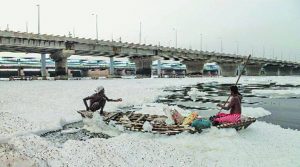Ammonia In Yamuna:

Water supply was disrupted in parts of Delhi once again when ammonia levels in the Yamuna river remained high on 16th April.
- The concentration of ammonia in the river was 7.4 ppm (parts per million), seven times the level of around 1 ppm that the Delhi Jal Board’s water treatment plants (WTPs) can process.
- The acceptable maximum limit of ammonia in drinking water, as per the Bureau of Indian Standards, is 0.5 ppm.
- Ammonia is a colourless gas and is used as an industrial chemical in the production of fertilisers, plastics, synthetic fibres, dyes and other products.
- It consists of hydrogen and nitrogen. In its aqueous form, it is called ammonium hydroxide.
- This inorganic compound has a pungent smell.
- Ammonia occurs naturally in the environment from the breakdown of organic waste matter.
- It is lighter than air.
- It may find its way to ground and surface water sources through industrial effluents or through contamination by sewage.
- If the concentration of ammonia in water is above 1 ppm it is toxic to fishes.
- In humans, long term ingestion of water having ammonia levels of 1 ppm or above may cause damage to internal organs.
- The most likely source is believed to be effluents from dye units, distilleries and other factories in Panipat and Sonepat districts in Haryana, and also sewage from some unsewered colonies in this stretch of the river.




